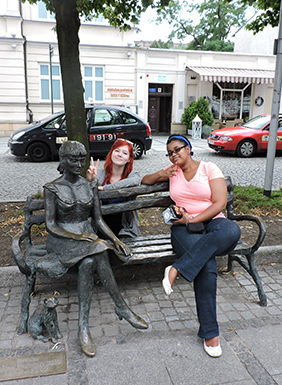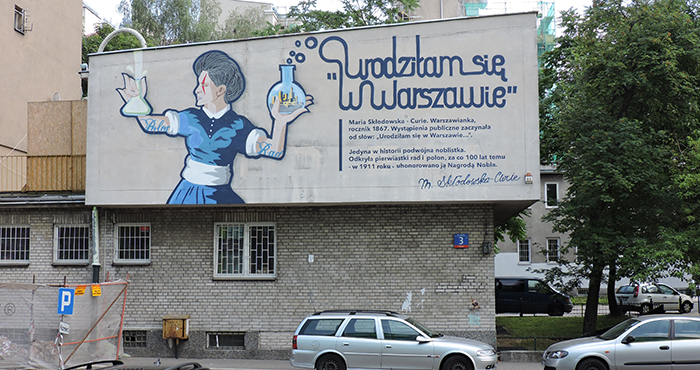Chemistry students Sophia King and Diana Chaykina took the opportunity to study abroad with Justyna Widera, Ph.D. in a location rooted in the sciences.

Sophia King ’16 (right) and Diana Chaykina ’16, chemistry majors, spent the 2015 summer researching nanoscale photocatalysis with Justyna Widera, Ph.D., professor of chemistry at Adelphi, at the University of Warsaw in Warsaw, Poland.
The 18th-century building at 16 Freta Street, in the New Town district of Warsaw, Poland, is a rather plain edifice with bits of flourish at the corners. But the namesake for and the symbolism behind its location is weighty. The Muzeum Marii Skłodowskiej-Curie is housed in the birthplace of pioneering female scientist and two-time Nobel Laureate Maria “Marie” Sklodowska-Curie, who discovered the radioactive isotopes polonium and radium and who is equally known for paving the way for women in the sciences. For Sophia King, a senior chemistry major, a stop at Freta Street during her study abroad reinforced her commitment to continuing Curie’s legacy of women in the sciences.
King spent Summer 2015 in Warsaw with fellow senior Diana Chaykina in the company of Adelphi University professor of chemistry Justyna Widera, Ph.D. The three were doing research on nanoscale photocatalysis at Dr. Widera’s alma mater, the University of Warsaw, part of a collaboration she embarked upon in 2014.
King and Chaykina are no strangers to life abroad. King is originally from Guyana, Chaykina from Belarus. Vivian Matubia ’15, who accompanied Dr. Widera and Chaykina in 2014, is from Nairobi. But the opportunity to work with Dr. Widera in a location rooted in the sciences made a significant impact on King, who also visited Toruń, the Polish hometown of Nicolaus Copernicus. “These visits to the homes of great scientists really made our work more real and meaningful for me,” she said.
Conducting research at the University of Warsaw proved to be even more enriching for King. She was able to work with such powerful scientific tools as scanning electron microscopes and a quartz crystal microbalance, a rare and highly sophisticated device that measures mass variations per unit area by observing frequency changes of a quartz crystal resonator.
Matubia echoed King’s enthusiasm: “The facilities at the University of Warsaw were exceptional. It was an opportunity to do research full time and to work with people whose papers I had read.”
Chaykina added, “Not only did I get to see what a bigger university is like, but I was there a full working day, every single day. And I got to meet a lot of people who are genuinely interested in what I’m doing.”
The experience of bringing the undergraduates to Warsaw—where her love of the sciences began—was more than fulfilling for Dr. Widera. She became interested in chemisty while growing up in Wieluń, Poland, a passion that eventually brought her to the University of Warsaw, where she earned her doctoral degree. For two consecutive years now, she’s had the opportunity to open this world of rich cultural and educational experiences to a new generation of women in the sciences. If fortune prevails, she will continue to offer the opportunity for the life-changing experiences that King simply describes as “awe-inspiring.”

A mural on a wall in Warsaw, Poland. Marie Curie discovered the radioactive isotopes polonium and radium. She was the first woman to win a Nobel Prize in 1903 and the only two-time winner so far, with her second award in 1911.
For further information, please contact:
Todd Wilson
Strategic Communications Director
p – 516.237.8634
e – twilson@adelphi.edu